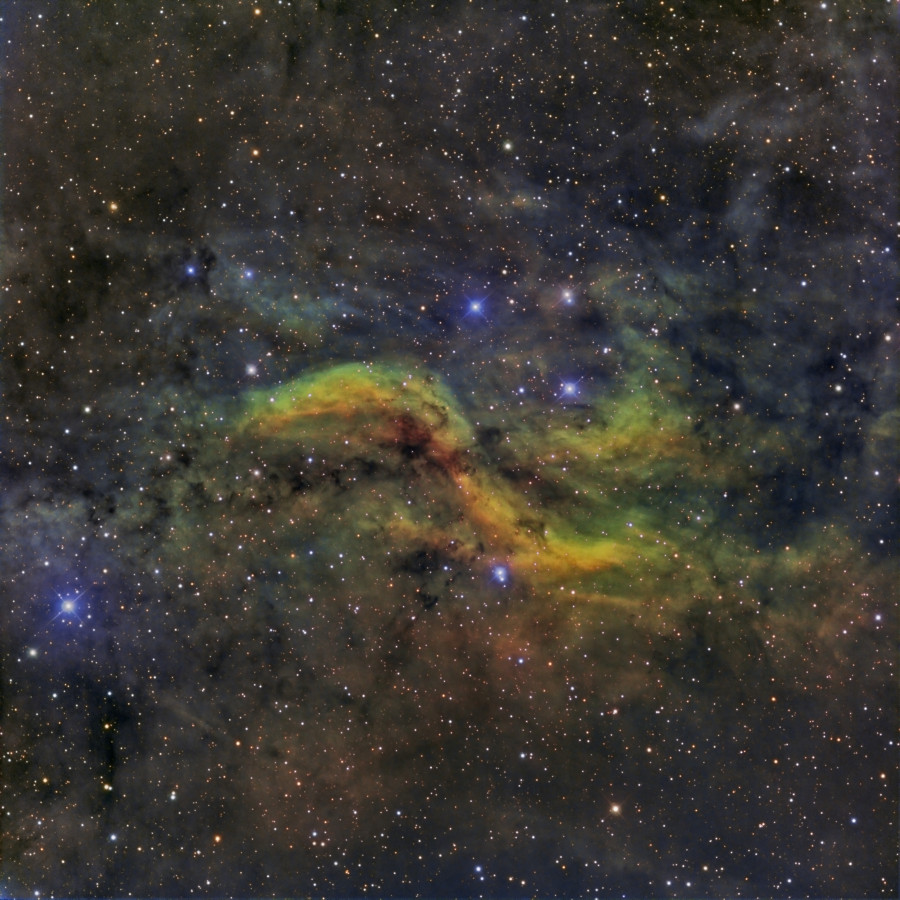Propeller nebulae-SHO-rgb
Commentaires sur l’objet photographié
Il aura fallu quasiment tout l’été, si on peut appeler cela un été ! traitement classique en SHO-rvb avec 20% d’apport de RGB sur la couche SHO.

Données techniques
Données techniques de prise de vue
Object : Propeller nebuale
Date images Du 29 juin au 7 aout 2021
Optics : Rcos 12.5″
Mount : Paramount ME Numéro 3
Location : Sirene observatory
Seeing : fwhm : 1.46 à 2.18 arc sec /pixel
Ccd : Apogee 16U
filter wheel : Apogee
filters : Astrodon
SIIHaOIII rvb
Focuser :TIM
Guiding : Atik 314L+
Temp. out : T°
Temp ccd : -25°
Total exposure : 49 h
tout en binning 1×1
SII : 29 x 20′
OIII : 36 x 20′
Ha : 54 x 20 ‘
RVB : 37 x 5′ pour chaque filtre
Rouge 30 x 5′ / vert 30 x 5′ / bleu 30 x 5’
Données scientifiques
The Propeller Nebula (Simeis 57 or DWB 111/119) is an emission nebula within the giant molecular cloud of Cygnus X located about 4500-6000 (estimated) light years from Earth in Cygnus. It was first catalogued in the 1950s by astronomers working at Simeiz Observatory in Ukraine as the 57th object in their catalogue containing 306 HII regions. In 1969, astronomers H.R. Dickel, H. Wendker and J.H. Bieritz published a paper labeling the central part of the Propeller Nebula separately as DWB 111 (southern arm) and DWB 119 (northern arm) with the bright patch surrounding it as DWB 118. The DWB catalogue contains 109 emission nebulae related to the Cygnus X star forming region. (credit: Gabor Toth Astrophotography and cosmicneighbors.net)
he entire complex was assigned Simeis 57 when it was discovered in the early 1950s by G.A Shajn and V.E. Hase at the Crimean Astrophysical Observatory at Simeis, Russia. Their results were published in the observatory’s Bulletin of the Crimean Astrophysical Observatory (in Russian, Izvestiya Krymskoi Astrofizicheskoi Observatorii), although they did not become widely known outside of the Soviet Union at the time, probably due to the Cold War raging at the time.
Later, portions of Simeis 57 were assigned separate designations in various catalogs. The propeller’s southern blade is listed as DWB 111, after a 1969 article detailing the Cygnus X region, written by H. R. Dickel, H. Wendker, and J.H. Bieritz that appeared in the journal Astronomy & Astrophysics (A&A, vol. 1, p. 270 – 280). The same article listed the northern blade as DWB 119. Fainter sections were assigned other DWB numbers, although for our purposes here, we will concentrate on trying to see the propeller itself. That’s tough enough. (Sidebar: For a more up-to-date review of the physics behind Simeis 57, read The peculiar nebula Simeis 57-I. Ionized gas and dust extinction, also published in Astronomy and Astrophysics [A&A vol. 398, p. 1063-1071].)
As with so many emission nebulae (or hydrogen-II regions, if you prefer), the Propeller Nebula is very difficult to see by eye alone. That’s because its primary emissions lie in the red portion of the visible spectrum, where our eyes are all but blind under dim light conditions. And they don’t come much dimmer than Simeis 57.
The blades of the propeller span about 20′, so in order to squeeze both into the same view, select an eyepiece with a real-field coverage of at least half a degree. A modern, ultra-wide design with an 80°-plus apparent field is better than, say, a more conventional Plössl, since their wide apparent fields also produce a higher magnification for the given real field. That’s important consideration, since higher magnification will generate better image contrast.
To boost contrast further, experiment with various nebula filters. Not to plant any preconceived prejudices in your mind, but narrowband (UHC-type) and O-III filters seem to offer little positive effect on the Propeller. On the other hand, a Hydrogen-Beta (Hβ) filter, which rarely seems to help objects beyond the Horsehead Nebula, usually proves to be the top choice here. But again, try each filter in your cadre and see which produces the best results.
The Propeller is 5° southwest of Deneb [Alpha (α) Cygni], and just to the west of a right triangle the 7th-magnitude stars SAO 49403, 49413, and 49418. While that triangle is obvious in the 8×50 finderscope attached to my 18-inch, the Propeller itself takes better skies than I can hope for from my suburban observatory. Under naked-eye limiting magnitude 6.5 skies, however, the 18-inch at 94x and with an Hβ filter in place reveals a very soft glow after a concentrated search.

